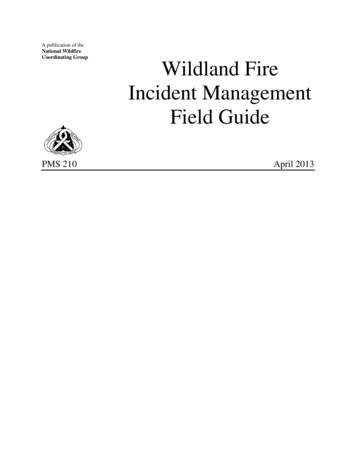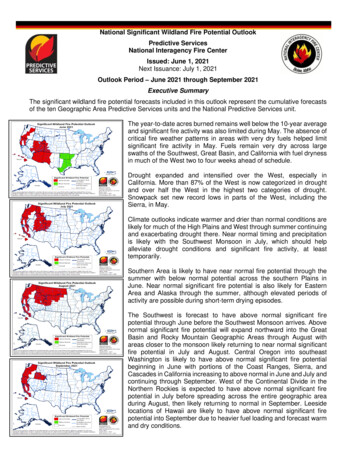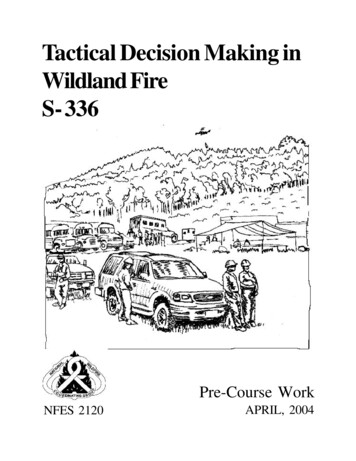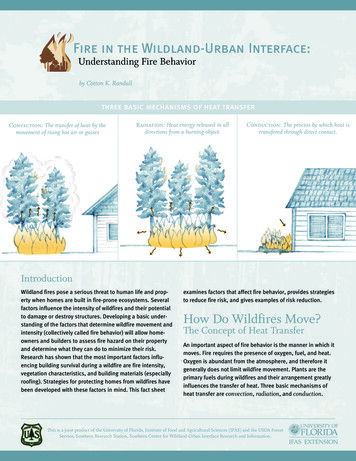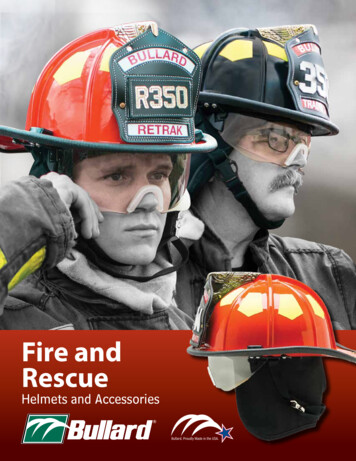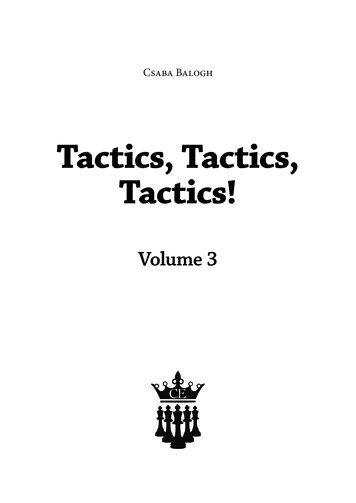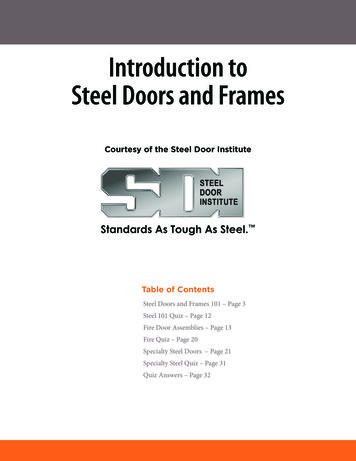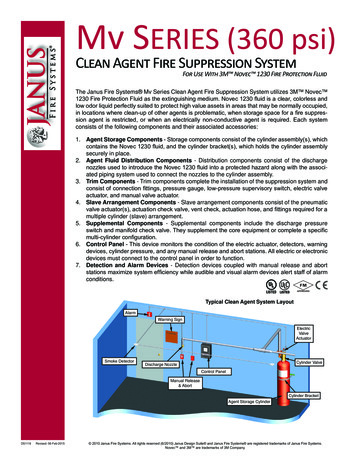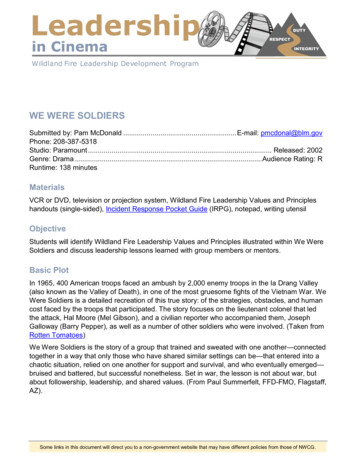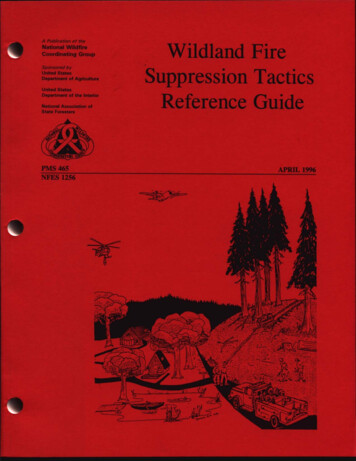
Transcription
PREFACEThe Wildland Fire Suppression Tactics Reference Guide is designed tosupplement courses that teach tactics in the Wildland Fire Qualification System.It can be used by the beginning firefighter to learn basic tactics as well as areview of fire suppression tactics for the advanced firefighter.This reference guide was developed under the direction of the National WildfireCoordinating Group Training Working Team with coordination and assistance ofFire Managers from the following agencies:United States Department of the InteriorBureau of Land ManagementNational Park ServiceBureau of Indian AffairsUnited States Department of AgricultureForest ServiceNational Association of State ForestersColorado State Forest ServiceMinnesota Division of ForestryWe appreciate the efforts those people associated with the design and developmentof this product.1
Additional copies of this publication may be ordered from:National Interagency Fire CenterATTN: Supply3833 S. Development Ave.Boise, Idaho 83705Order NFES #125611
CONTENTSINTRODUCTION TO REFERENCE GUIDE. 1FIRE ORDERS2WATCH OUT SITUATIONS3LOOKOUTS, COMMUNICATIONS, ESCAPE ROUTES, SAFETY ZONES(LCES)4SECTION 1 - FIRE SUPPRESSION PRINCIPLES5Fire Sizeup and Initial AttackHow to Attack a FireWhere to Attack a FireFireline LocationFireline FlaggingFireline ConstructionCoyote TacticCrew Production RatesFireline ExplosivesMopupMinimum Impact Suppression Tactics (MIST)715182026293638414448SECTION 2 - USE OF WATER AND ADDITIVES57Types of PumpsHydraulicsSeries, Parallel, and Staged PumpingHose LaysMopupTactical Use of WaterSurfactantsClass A Foam.RetardantsFiregels1115962717578799293101101
SECTION 3 - USE OF FIRE IN CONTROL OPERATIONSBurning Out and BackfiringTypes of Fire SpreadIgnition TechniquesStrip FiringOne, Two, Three - Three, Two, One (1-2-3/3-2-1) Firing ConceptHead and Strip Head FiringBlowhole FiringSpot FiringRing FiringChevron FiringBurn StripPlanning and Conducting Firing OperationsSpecial Firing ConsiderationsFiring EquipmentSECTION 4 - MECHANICAL EQUIPMENTDozersComparison of Dozers Used For Fireline ConstructionDozer Production RatesDozer Line Construction PrinciplesTractor PlowsPrinciples of Tractor/Plow OperationsEnginesMobile AttackTandem TacticPincer TacticEnvelopment TacticStationary AttackInside-out TacticParallel AttackEngine Production 27131133134140144148149153156157158159160161162164
SECTION 5 - TACTICAL AIR OPERATIONSFactors Affecting Aircraft UseFactors to Consider in Retardant Aircraft UseTypes, Effects, and Use of RetardantRecommended Retardant Coverage LevelsRetardant Evaluation CriteriaAir Tanker TacticsPrinciples of Retardant ApplicationSECTION 6 - WILDLAND/URBAN INTERFACEKinds of Wildland/Urban InterfaceStructural Fire BehaviorWildland/Urban Fire Sizeup ConsiderationsStructure TriageWildland/Urban Interface Firefighting TacticsStructure Full ContainmentStructure Partial ContainmentStructure No ContainmentStructural Firefighting Situations That Shout "Watch Out"Structural Watch Out Situations & Triage Made Easier to 194195196200201SECTION 7 - FlTELS, FIRE BEHAVIOR, AND TACTICS BY GEOGRAPHICAREAS OF THE UNITED STATES203AlaskaNorthwest and Northern Rocky MountainsSouthern and Central CaliforniaGreat Basin and Southern Rocky MountainsSouthwestNortheastSoutheastGLOSSARY OF TERMS205219237257283297313333v
VI
INTRODUCTIONThe Wildland Fire Suppression Tactics Reference Guide provides basic tacticalinformation on suppressing wildland fires. It also provides information onwildland fire fuels, fire behavior, and tactics by geographic areas of the UnitedStates.It can be used by the beginning firefighter to learn more about tactics ordetermining exactly where and how to build a control line and what othersuppression measures are necessary to extinguish a fire.It can be used as a review of fire suppression tactics for the advanced firefighter.The tactics reference guide is intended to be a supplement, but not a substitute forwildland fire training. It does not qualify a person for any wildland firefightingposition.This guide does not include nor address the constraints on firefighting imposedby environmental laws and regulations; i.e., designated wilderness areas,wilderness study areas, threatened and endangered species, cultural andarcheology sites, air quality, etc.1
FIRE ORDERSFight fire aggressively but provide for safety first.Initiate all action based on current and expected fire behavior.Recognize current weather conditions and obtain forecasts.Ensure instructions are given and understood.Obtain current information on fire status.Remain in communication with crew members, your supervisor andadjoining forces.Determine safety zones and escape routes.Establish lookouts in potentially hazardous situations.Retain control at all times.Stay alert, keep calm, think clearly, act decisively.2
WATCH OUT SITUATIONS(Survival Checklist)Fire not scouted and sized up.In country not seen by daylight.Safety zones and escape routes not identified.Unfamiliar with weather and local factors influencing fire behavior.Uninformed on strategy, tactics and hazards.Instructions and assignments not clear.No communication link with crew members/supervisor.Constructing fireline without safe anchor point.Building fireline downhill with fire below.Attempting frontal attack on the fire.Unbumed fuel between you and the fire.Cannot see main fire, not in contact with anyone who can.On a hillside where rolling material can ignite fuel below.Weather is getting hotter and drier.Wind increases and/or changes direction.Getting frequent spot fires across line.Terrain and fuels make escape to safety zones difficult.Taking a nap near the fireline.3
LOOKOUTS, COMMUNICATIONS, ESCAPE ROUTES, SAFETY ZONES(LCES)Figure 1 displays the concept of LCES which is posting lookout(s) if you cannotsee the fire, maintaining communications between the lookout(s) and firefighters,and always knowing your escape route(s) and safety zone(s). If LCES isconstantly practiced the Standard Firefighting Orders and Watch Out Situationswill not be compromised.Figure I-LCESI LeES ILookout(s) -- -- Communication(s)--r(f)ObjectiveHazard Escape Route(s)ySafety Zone(s)LeES must be established & known toALL firefighters BEFORE needed.4
SECTION 1 - FIRE SUPPRESSION PRINCIPLESStrategy is an overall plan of action for fighting a fire which gives regard to themost cost efficient use of personnel and equipment in consideration of resourcevalues threatened, fire behavior, legal constraints, and objectives established forresource management.Tactics are the operational aspects of fire suppression. Determining exactlywhere and how to build a control line and what other suppression measures arenecessary to extinguish a fire. Tactics must be consistent with the strategyestablished for suppressing a fire.The purpose of this section on fire suppression principles is to acquaint allfirefighters with the factors to size up a fire and apply the strategy and tactics thatwill enable an appropriate suppression response to be completed in a safe,efficient manner, and facilitate rehabilitation of the suppression impacts.Most wildland fires are suppressed by initial attack (first to arrive) forces. Somewildland fires become large for various reasons. Fire suppression principlesapply to initial attack as well as to large fires or parts of large fires.5
61111111111111111111111111111111111I
FIRE SIZEUP AND INITIAL ATTACKOften times firefighters and incident commanders take shortcuts concerning firesizeup, establishing communications and safety. A thorough fire sizeup,establishing communications among all resources on a fire, and applying safety toall aspects of fire suppression are critical elements that must be adhered to. Ifadequate communications can not be established and firefighter safety iscompromised then it is time to back off and re-evaluate your tactics.If you are assigned to fight fire in an area where you are unfamiliar with thelocal fuels, weather, topography, and fire behavior you should request a briefingfrom the local agency, to provide you with this information.In many cases sizeup and initial attack go hand in hand because the firefighterwith a passion for safety begins to gather information about the fire situationfrom the initial dispatch and/or prior to departing to the fire incident.En route To A FireEn route to a fire begin to think about your knowledge of the fire area and howcurrent conditions compare to past experiences. Some items to consider are: Firefighter safety. Fuels and terrain. What are the fuels? Are they heavy timber types orlight, flashy, grass types? Are the fuels sheltered from direct solarradiation due to aspect or cover? Is the terrain steep or gentle? How doyou expect this fire to bum compared to recent fires in similar areas? Weather-is the windspeed greater or less than the forecast? Is it fromthe same direction? Are there dust devils or gusty winds that wouldindicate erratic behavior? Is the humidity about what was forecast? Arethere any indicator clouds or thunderstorms? Smoke column-check size, height, color, direction and shape.The greater the height and size of the column the greater the fireintensity. A fractured (bent over by the wind) column indicates a wind driven fire. Wind-driven fires can pose serious threats to safety as thefire grows. Spotting can become long range creating new fires ahead ofthe main fire. However, direction and rate of spread is morepredictable.7
A large developing mushroom shaped column can indicate a plume dominated fire where the fire's rate of spread and direction is veryunpredictable. Strong wind indrafts and downbursts can occur withshort range spotting in all directions.Light colored smoke generally indicates lighter burning fuels whereas adark colored smoke indicates heavier burning fuels such as brush ortimber. Access routes and their limitations-also look for alternate rOlltes. Fire barriers (natural and human made). Potential water sources. Land ownership (including cooperative agreements and assistance on firesuppression). History of fires in area and cause. Capabilities of responding resources and available back-up forces. Look for people coming from the fire area or suspicious people at thefire scene. Write down license plate numbers and descriptions of vehiclesand/or people. Public safety concerns.Arrival On Fire SceneSafety of assigned resources, facilities, and the public should always be a primeitem to consider when evaluating possible attack options. An appropriate decisionalways provides for safety first. The Fire Orders, Watch Out Situations, and theLCES system are to be implemented and reviewed often.After arrival on the fire scene, your next decisions are critical to initial attacksuccess. This is where you "make it or break it." If you go off in all directionslittle will be accomplished and firefighter safety could be jeopardized. You needto gather additional critical information to complete the fire sizeup andformulate an appropriate plan of attack.These are the key factors you should observe in relation to fuels, weather,topography, and fire behavior during your sizeup process:8
Fuels: Type/model. Size classes present and size classes burning. Are fuels light and continuous? Live/dead ratio (frost, bug kill, drought conditions). Fine dead fuel moisture (dangerous below 6%). Live fuel moisture (chaparral, sagebrush, Gambel oak, etc.) Vertical arrangement and horizontal continuity (ladder fuels, tight crownspacing less than 20 feet). Loading (heavy vs. light). Snag concentrations. Areas with rebum potential. Access restrictions for personnel.Some fuels such as chamise, chaparral, pines, palmetto-gallberry, junipers,mountain laurel, rhododendron, and eucalyptus burn hotter and produce longerflame lengths than others because they contain flammable oils.Generally, taller and thicker fuel will produce longer flame lengths and controllines must be wider.Heavy fuels do not ignite easily and fires do not spread as fast as in light fuelssuch as grass, leaves, needles, and twigs. However, once ignited, logs, snags, andheavy branches bum for a long time and may require wide control lines to keepthe flame, sparks, or radiated heat from igniting fuels across the line.Fuel moisture and whether fuel is dead or alive have a definite effect on aburning fire's intensity. Generally, the drier the fuel the hotter it burns andlonger flame lengths are produced. Longer flame lengths require wider firelinesto stop the fire.9
Topography: Aspect. Position on slope (ridge top, mid-slope, drainage bottom). Building line downhill or uphill. Width of canyons (wide/narrow). Box canyons and/or chutes. Percent slope. Potential for rolling material. Available natural and/or constructed barriers. Elevation.When a fireline is built above a fire burning on a slope, generally the steeper theslope, the wider the line must be because the fire usually burns faster and moreintensely than on a gentler slope. The more gentle the slope the narrower the linecan be.When a fireline is built below a fire burning on a slope, the width of the line doesnot depend so much on the slope, but trenching becomes important. Generallythe steeper the slope, the deeper the trench must be, to prevent rolling burningmaterial from crossing the fireline.Weather: Maximum/minimum relative humidities. Wind velocity, direction and patterns (gusty vs. steady). Temperature variations. Thermal belts. Thunderstorm activity. Diurnal wind patterns and windspeed.10
Inversions. Foehn winds. Battling winds or sudden calm.When a gravity or foehn wind interacts with a local wind, significantwind reversals are likely. Definite indicators are winds battling back andforth causing a wavering smoke column and a sudden calm.A decreasing foehn wind that allows a local wind to regain influence canbe as dangerous as the foehn wind that overpowers a local wind. A windreversal from a decreasing foehn wind has been a factor in severalfatality fires. Weather forecasts (request spot weather forecast if predicted weathercondition is unknown). Last precipitation and amounts. Indicators of turbulence (dust devils, thunderstorms, lee sides of ridges,saddles). Indicators of instability (clear visibility, smoke rising straight up,inversions lifting). Indicator clouds. Haines Index 5 or 6.In general the higher the temperature and the lower the humidity, the lower thefuel moisture. The lower the fuel moisture, the more intensely a fire will burnand the wider the fireline must be.The wind or air currents increase the burning intensity by supplying moreoxygen, by moving currents of hot, drying air into the fuels ahead, or by actuallycarrying burning embers (spotting) ahead of the fire itself. Therefore, thestronger the wind or convection current, the wider the line must be.11
Fire Behavior: Rate of spread on various portions of the fire. Flame lengths on various portions of the fire. Type of fire spread (smoldering, creeping, running, torching, spotting). Classification of fire (ground, surface, aerial [trees torching]). Indicators of extreme fire behavior (a rapid buildup of intensity, a highsustained rate of spread, a well developed convection column, frequent orlong distance spotting [600 feet or more], firewhirls, horizontal flamesheets) Size of fire. Location of fire in relation to topographic features (chutes, canyonbottoms, ridge tops, mid-slope).Flame length is an important fire behavior factor you should be concerned withduring sizeup. Generally fires with flame lengths greater than 4 feet are toointense for direct attack on the head by persons using hand tools (see Figure 2).Figure 2-Fire Suppression Limitations Based On Flame Length*Flame Length4'Fires can generally be attacked at the head or flanks bypersons using hand tools. Handline should hold the fire.4'-8'Fires are too intense for direct attack on the head bypersons using hand tools. Handline cannot be relied onto hold fire.8'-11'Fires may present serious control problems; torchingout, crowning and spotting. Control efforts at the headwill probably be ineffective. 11'Crowning, spotting and major fire runs are probable.Control efforts at the head of the fire are ineffective.*This may be modified for local fuels and conditions.12
Other critical elements to consider: Restrictions on suppression tactics (wilderness areas, threatened andendangered species, etc.). Span of control. Biological and environmental hazards. Constructed hazards (powerlines, hazardous waste dump sites). Urban interface. Availability of critical support (hose lays, helicopter/fixed wing). Physical and mental condition of assigned resources. Ability to re-supply. Availability of human made and natural barriers (game trails, cow paths,roads, trails, lakes, rivers, old burns). Availability of water sources. Observation points. Archeological sites. Cultural resource sites. Accessibility and mobility. Poor visibility. Coordination with dispatch and/or adjoining forces. Other agency involvement.13
Now that you have sized up the fire the following decisions need to be made: How to establish and implement lookouts, communications, escape routes,and safety zones (LCES). How to attack the fire (direct, parallel, indirect attack). Where to anchor and attack the fire (rear, flanks, head). Organization and command structure. Location of control line. Type of control line (width, burnout). Additional help needed.Considering the following factors will help make the decisions above. Firefighter safety. Size of fire and fire behavior. Fire environment (fuels, weather--current and predicted, topography). Forces presently available to construct control line and hold it. Location of the fire head. Period of day fire is burning into (morning, afternoon, night). Improvements and other values in path of fire. Point of origin and cause. Public safety.14
HOW TO ATTACK A FIREIf you are the first person to arrive at a fire or a single resource boss in chargeof the first crew at a fire, you have several problems. You are confronted withdeciding; 1) what is the most important work to do first, and 2) where the mosteffective work can be done. Keep in mind at all times that firefighter safety isthe highest priority in fire suppression.After sizing up the fire you need to select an anchor point and make your attack.Following are some good practices in making an initial attack or suppressing alarge fire. If you are the incident commander, establish an organization andcommand structure. Make sure your subordinates know the plan and arekept informed on changing conditions, tactics and/or strategies. Use water or dirt to cool and extinguish hot spots. Anticipate future control action when the fire cannot be containedpromptly. Construct fireline uphill from an anchor point. As a first effort, keep fire out of the most dangerous fuels, and prevent itfrom becoming established in explosive types of fuels, such as grass,thickets of tree seedlings, heavy brush, or slash areas. Confine fire as quickly as possible. Locate and build firelines. Move all rollable material so it cannot rollacross firelines. Leave no significant areas of unburned material close to fireline. To gain control, swiftly locate and build fireline in the easiest and safestplaces for line construction that can be held. Burn out as needed whenline is constructed and burning out can be controlled. Utilize existing barriers to full extent. If fire spread cannot be contained, notify dispatch and do some safe,effective work on at least a part of the fire. Where improvements (houses, other buildings, fences) are involved,consider all the facts before determining which point to attack first. Noimprovement or piece of property is worth firefighter injury or fatality.15
Now a decision must be made concerning how to attack a fire. The methods ofattack are direct, parallel, and indirect.Direct attack is made directly on the fire's edge or perimeter (see Figure 3). Theflames may be knocked down by dirt or water and the fire edge is generallytreated by a follow-up fireline. Or, a fireline is constructed close to the fire'sedge and the fuel between the fireline and the fire is burned out or the fire isallowed to bum to the fireline.Direct attack generally works best on fires burning in light fuels or fuels withhigh moisture content burning under light wind conditions. Direct attack workswell on low intensity fires (flame lengths less than 4 feet) which enablefirefighters to work close to the fire.A major advantage of direct attack is firefighter safety. Firefighters can usuallyescape back into the burned area for a safety zone. This is known as "keepingone foot in the black."16
Parallel attack is made by constructing a fireline parallel to, but further from, thefire edge than in direct attack (see Figure 4). This tactic may shorten firelineconstruction by cutting across unburned fingers. In most cases the fuel betweenthe fireline and the fire edge is burned out in conjunction with firelineconstruction.Figure 4-Parallel Attack!?Olrf)Indirect attack is accomplished by building a fireline some distance from the fireedge and backfiring the unburned fuel between the fireline and the fire edge (seeFigure 5). Indirect attack takes advantage of using natural and human-madebarriers as fireline and allows a choice of timing for backfiring. Indirect attackis generally used on hot fires with high rates of spread where direct attack is notpossible.Figure 5-Indirect Attack17
WHERE TO ATTACK A FIREThe parts of the fire to be controlled are the head, the flanks, and the rear (seeFigure 6).Figure 6-Parts Of A FireHeadLeftFlankFires are generally attacked where they are most likely to escape and this mayrequire attacking the fire at the head, flanks, rear, or any combination of thethree. However, your primary concern is attacking the fire where it can be donesafely. A good practice is to always pick an anchor point to start fighting the fireand to prevent the fire from outflanking you.Fireline intensity (flame length) and rate of spread generally determine whichpart of the fire to attack in both initial attack and suppressing large fires. Figure2-Fire Suppression Limitations Based On Flame Length, page 12, providesguidance to make decisions on which part of the fire to attack and whether tomake a direct, parallel, or indirect attack.18
A technique to attack a fire where it is most likely to escape or stop hotterburning portions of a fire is called hotspotting (see Figure 7).Figure 7-Hotspotting, Using Temporary LinesTo Check Fire Spread And Gain TimeHotspotting can be used to cool hot portions of a fire and allow firefighters moretime to construct fireline or cool certain portions of a fire to prevent it frommaking a run. Hotspotting can be accomplished by building temporary checklines or applying dirt or water to knock down and cool hot portions of a fire.Hotspotting can be dangerous to firefighters because they are working without ananchor point, can be out-flanked by fire, and they are exposing themselves tointense burning portions of a fire.19
FIRELINE LOCATIONFollowing are some general principles of fireline location:Locate the fireline as close to the fire edge as possible. This generally means adirect attack which provides firefighters more safety as they can usually get intothe burned area for a safety zone.Always anchor the fireline to a barrier or other control line to prevent beingoutflanked by the fire (see Figure 8). Barriers can be natural or human madei.e., roads, trails, rivers, lakes, old bums, rocks. Also burn out the fuels betweenthe fireline and the fire edge beginning at the anchor point and continue burningout as the fireline is constructed.Figure 8-Begin Fireline At Anchor PointAnchor PointsIf the fire is spreading rapidly or is too hot for direct attack, place the fireline farenough back from the fire's edge to allow sufficient time for fireline constructionand burning out to be completed safely.20
Avoid downhill fireline construction with the fire directly below. Buildingfireline downhill when fire (either wildland fire, burnout, or a backfire) isdirectly below you can be hazardous and is one of the Watch Out Situations (seeFigure 9). Fire spreads more rapidly upslope. Firefighters above the firebuilding fireline downhill can easily be outflanked or overrun by the fire.Figure 9-Building Fireline DownhillWhen building fireline downhill all of the following safety precautionsmust be adhered to:1.The decision is made by a competent fireline supervisor afterthorough scouting.2.Downhill fireline construction should not be attempted when fire ispresent directly below the proposed starting point.3.The fireline should not be in or adjacent to a chimney or chute thatcould bum out while firefighters are in the vicinity.4.Communication is established between firefighters workingdownhill and firefighters working toward them from below. Whenneither crew can adequately observe the fire, communications will21
be established between the crews, supervising overhead, and alookout posted where the fire's behavior can be continuouslyobserved.5.Firefighters will be able to rapidly reach a safety zone from anypoint along the line if the fire unexpectedly crosses below them.6.A downhill fireline will be securely anchored at the top. Avoidunderslung line if at all practical.7.Burning out should be done as the fireline progresses, beginningfrom the anchor point at the top. The burned out area provides acontinuous safety zone for firefighters and reduces the likelihoodof fire crossing the line.8.Be aware of and recognize the Watch Out Situations.9.Full compliance with the Fire Orders is assured.10. Implement LeES.Fireline should not be constructed in or adjacent to chutes or box canyons thatcan channel the fire and produce extreme fire behavior (see Figure 10).Figure 10-Fireline Constructed Near Chute or Box Canyon--- .\\\\-----\\\\\'\\,","'-' ,22
Make the firelineas short as possible (see Figure 11). Tie ends of fingerstogether with a fireline and promptly bum out. Cold trailing is a method ofusing the extinguished edge of a fire as the fireline. The cold fire edge must becarefully inspected to detect any fire and every live spot must be lined andextinguished. Cold trailing can shorten the fireline to be constructed, but must beaccomplished with caution.Figure l l-s-Short FirelineCapitalize on existing barriers to fire spread in selecting fireline location.When possible put the fireline through open areas to reduce clearing work.Avoid sharp angles in the fireline.Block off high hazard fuels where possible by leaving them outside the fireline.23
When constructing fireline on a ridgetop, locate the fireline on the back side ofthe ridge (see Figure 12).Figure 12-Properly Located Fireline On Ridgetop,.-.--CONTROL LiNEWhen constructing fireline in the bottom of a canyon locate line on the oppositeside to prevent underslung line and the need for cup trenching (see Figure 13).Figure 13-Properly Located Fireline In Canyon Bottom24
Locate the fireline far enough away from burning snags to enclose them if theyfall over or are cut down (see Figure 14).Figure 14-Properly Located Fireline With Snags Close to Fire Edge' :::";'/'//,, .'\.,.--,.,. .-- .,.Encircle the area where spot fires are so numerous that individual control ofthem is impracticable.Where a definite topographic feature, such as a ridge, cannot be used for firelinelocation, oblique (slanting) lines should be used for frontal attack to pinch off thefire head, rather than a line squarely across the front.Take advantage of the normal daily shift between local up-canyon drafts duringthe day and down-canyon winds during the night. Unless general winds counterthe effect of local drafts, fires generally burn up-canyon during the day anddown-canyon at night.25
FIRELINE FLAGGINGLine location is a common practice in some types of terrain and fuels,particularly when a fire is burning in timber.When locating firelines, consider the following flagging techniques:1.When tying and positioning individual flags, allow enough time for crewor mechanical equipment to construct line before fire edge approaches flagline.2.Avoid flagging long sections of line. Flagging long sections of lineseparates you from your crew and equipment creating possiblecommunication problems and unsafe situations.3.Use a high visibility/reflective color whenever possible that can be easilyseen in day light or night time conditions. Notify the crews constructingfireline what color of flagging was used.4.Deploy an adequate amount of flagging for conditions. Flagging must bedeployed heavier for night operations and/or during heavy fuel buildupsbecause of poor visibility. Resources that can't find flag lines arenonproductive and may be put at risk during critical fire behaviorsituations and/or when working in adverse topography.5.Avoid flagging dog legs or sharp angles. Whenever possible flag awayfrom snags, widow makers, and other potentially hazardous areas.6.If possible avoid flagging underslung line conditions which will requiretrenching and future holding problems. Depending on the size or thecomplexity of the fire, more than one individual with radio(s) may berequired to accomplish this task. Whether locating line downhill or uphill,the outside perimeter will take on an overall wedge shape configurationand all unburned material should be burned out. On larger fires, anindirect method of attack may be warranted requiring flag lines to takeadvantage of ridges running parallel to the main fire. The unburned areat
The Wildland Fire Suppression Tactics Reference Guide is designed to . supplement courses that teach tactics in the Wildland Fire Qualification System. It can be used by the beginning firefighter to learn bas
